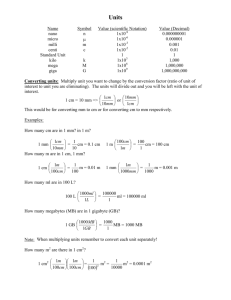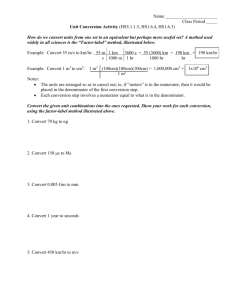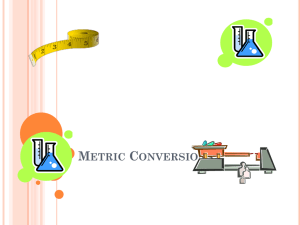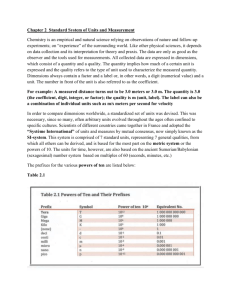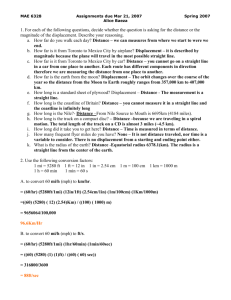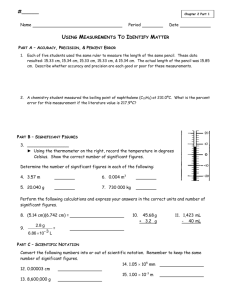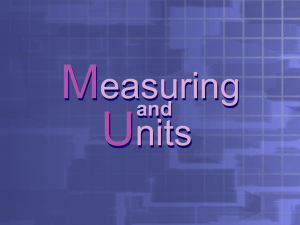APPENDIX 2 UNIT CONVERSIONS
advertisement
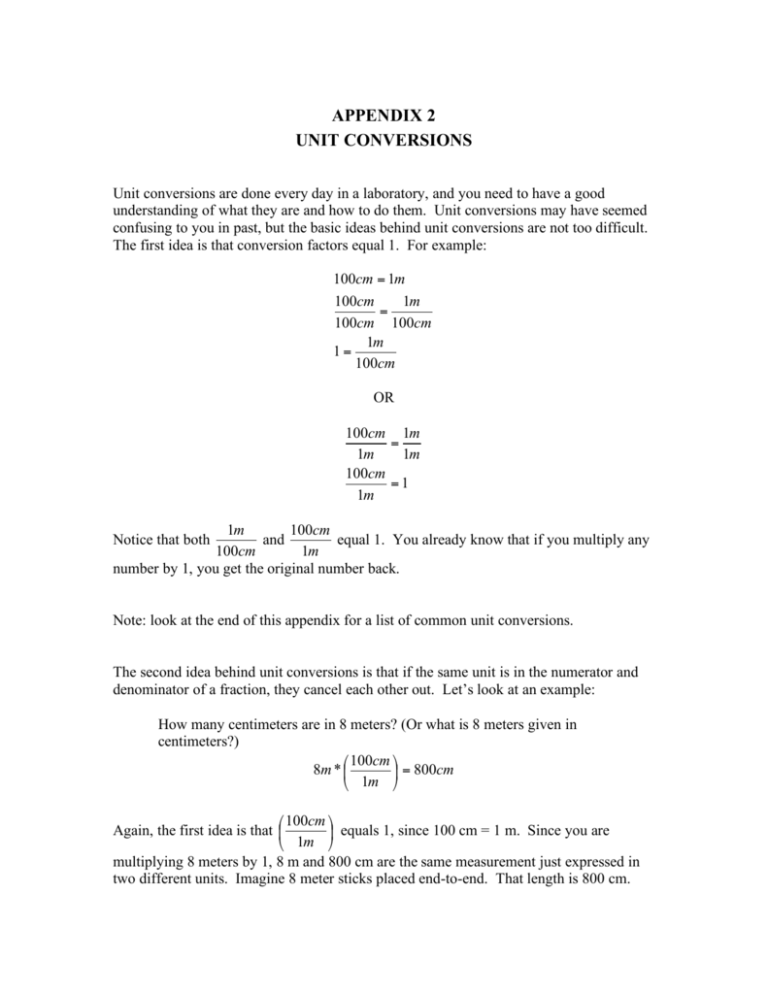
APPENDIX 2 UNIT CONVERSIONS Unit conversions are done every day in a laboratory, and you need to have a good understanding of what they are and how to do them. Unit conversions may have seemed confusing to you in past, but the basic ideas behind unit conversions are not too difficult. The first idea is that conversion factors equal 1. For example: 100cm = 1m 100cm 1m = 100cm 100cm 1m 1= 100cm OR 100cm 1m = 1m 1m 100cm =1 1m 1m 100cm and equal 1. You already know that if you multiply any 100cm 1m number by 1, you get the original number back. Notice that both Note: look at the end of this appendix for a list of common unit conversions. The second idea behind unit conversions is that if the same unit is in the numerator and denominator of a fraction, they cancel each other out. Let’s look at an example: How many centimeters are in 8 meters? (Or what is 8 meters given in centimeters?) & 100cm # 8m * $ ! = 800cm % 1m " & 100cm # Again, the first idea is that $ ! equals 1, since 100 cm = 1 m. Since you are % 1m " multiplying 8 meters by 1, 8 m and 800 cm are the same measurement just expressed in two different units. Imagine 8 meter sticks placed end-to-end. That length is 800 cm. Appendix 2: Unit Conversions & 1m # & 100cm # Of course, $ ! also equals 1. So, why do we multiply by $ ! , and not % 100cm " % 1m " & 1m # $ ! ? The reason is that this allows us to cross out the unit “meters” in the original % 100cm " value. As shown below, the unit “meters” in 8 m and the “meters” in the bottom part of the conversion factor cancel each other out: & 100cm # & 8m # &8# 8m * $ !=$ ! * 100cm = $ ! * 100cm = 8 * 100cm = 800cm % 1m " % 1m " %1" When deciding which unit conversion factor to use, pick the one that will remove the original units and will leave the units you want. What happens if you choose the wrong unit conversion? Let’s see: m2 & 1m # 8m ' $ ! = 0.08 cm % 100cm " The units become more complicated, and the original unit still remains. This is obviously not what you want. Let’s do another more complicated example: How many seconds are in a year? (Or: What is 1 year given in seconds?) & 365days # !! = 365days . 1) We start by converting 1 year into days: 1 year * $$ % 1 year " & 24hours # !! = 8760hours . 2) Next we convert days into hours: 365days * $$ % 1day " & 60 min # 3) Then we convert hours into minutes: 8760hours * $ ! = 525,600 min . % 1hour " 4) Finally we convert minutes into seconds: & 60 sec # 525,600 min* $ ! = 31,536,000 sec . % 1 min " To save time, we can do all of the calculations in one step: & 365days # & 24hours # & 60 min # & 60 sec # !! * $$ !! * $ 1 year * $$ !*$ ! % 1 year " % 1day " % 1hour " % 1 min " By canceling out units, the conversion formula simplifies to: 365 * 24 * 60 * 60 sec = 31,536,000 sec . Appendix 2: Unit Conversions If you become used to this system, you can quickly construct these “chains” of conversion factors, which is very powerful. Notice that 1 year and 31,536,000 seconds are the same extent of time. You haven’t actually changed the length of time, only the units in which time is expressed. One year is 31,536,000 seconds. If you wanted to count to 31,536,000 and you counted one number every second, it would take you one full year. If you wanted to count to 1 billion it would take you over 31 years! Do the math to see if that’s right. Up to now, we have converted large units into smaller units. Let’s go in the opposite direction, from a small unit to a bigger unit: How many liters equal 56430 milliliters? & 1L # 56430mL * $ ! = 56.43L % 1000mL " Let’s look at this in detail: & 1L # & 56430mL # 56430mL * $ !=$ ! * 1L = 56.43 * 1L = 56.43L % 1000mL " % 1000mL " The situation becomes even more complicated when you need to convert both a unit in the numerator and a unit in the denominator. For an example, let’s look at converting the concentration of a solution. We dissolve 1 milligram of salt (NaCl) in 1 ml of water. The concentration of this solution is 1mg/ml. To express the concentration of salt in the solution in terms of moles per liter (mol/L) we need to convert mg/mL to mol/L. 1) First convert the top number, noticing that the milligrams and grams cancel out: & 1mgNaCl # & 1molNaCl # & 1g # !! * $$ !! = 0.0000171molNaCl / mL $ ! * $$ % 1mL " % 58.5 gNaCl " % 1000mg " 2) Next convert the bottom number, noticing that the mL’s cancel out: & 0.0000171mol # & 1000mL # $ !*$ ! = 0.0171mol / L 1mL % " % 1L " Of course, we can also do the entire calculation in one step: & 1mgNaCl # & 1molNaCl # & 1g # & 1000mL # & 1mol # !! * $$ !! * $ $ ! * $$ !=$ ! = 0.0171mol / L % 1mL " % 58.5 gNaCl " % 1000mg " % 1L " % 58.5L " One milligram of NaCl per milliliter of H2O equals 0.0171 moles of NaCl per Liter of H2O. They are the same concentration, just expressed in different units! Appendix 2: Unit Conversions Here’s another example: How many cm2 equal 0.023 m2? You know you want to multiply 1 m2 by a conversion factor with m2 in the denominator and cm2 in the numerator, but how many cm2 equal 1 m2? 100cm = 1m 100 2 cm 2 = 12 m 2 10000cm 2 = 1m 2 First, we know that 100 cm = 1 m. Next, square both sides of the equation. Now the conversion factor is easy to find. We divide both sides by 1 m2 (since we want m2 in the denominator) and get: 10000cm 2 =1 1m 2 Again, the conversion factor equals 1. Now let’s solve the problem: & 10000cm 2 # !! = 230cm 2 0.023m 2 * $$ 2 % 1m " Appendix 2: Unit Conversions Metric/SI prefixes: M = mega = 106 K = kilo = 103 d = deci = 10-1 c = centi = 10-2 m = milli = 10-3 µ = micro = 10-6 n = nano = 10-9 These prefixes can be used to make unit conversion factors for any SI units. For example: 1 megameter (Mm) = 1 x 106 meters (m) 1 milliliter (mL) = 1 x 10-3 liters (L) => 1 x 103 milliliters (mL) = 1 liter (L) 1 kilogram (kg) = 1 x 103 grams (g) Common Unit Conversions: Length 1 inch = 2.54 centimeters (cm) 1 foot = 0.3048 meters (m) 1 mile ≈ 1.61 kilometers (km) 1 angstrom = 1 x 10-10 meters (m) Volume 1 cubic centimeter (cc) = 1 x 10-6 cubic meter (cu m) 1 cubic centimeter (cc) = 1 milliliter (mL) 1 fluid ounce (oz) ≈ 29.6 milliliters (mL) Weight or Mass 1 metric ton (t) = 1000 kilograms (kg) 1 pound (lb) ≈ 0.45 kilograms (kg) Avogadro’s number = 6.022 x 1023 = number of molecules of a substance that make up a mass in grams equal to its molecular mass 1 mole (mol) = mass of a substance in grams equal to its molecular mass 1 mole = 6.022 x 1023 molecules Concentration Molarity (M) = moles of solute per liter of solvent (mol/L) Molality (m) = moles of solute per kilogram of solvent (mol/kg) Normality (N) = Molarity (M) x number of protons or hydroxide ions per molecule For example: 1 M HCl = 1 N HCl 1 M H2SO4 = 2 N H2SO4 2 M H2SO4 = 4 N H2SO4 1 M Ca(OH)2 = 2 N Ca(OH)2 Appendix 2: Unit Conversions Time 1 year = 365 days (except during leap years) 1 day = 24 hours 1 hour = 60 minutes 1 minute = 60 seconds Temperature °C = (5/9) * (°F – 32) °F = (1.8 * °C) + 32 K = °C + 273.15 °C = K – 273.15 Water freezes at 0°C and boils at 100°C Water freezes at 32°F and boils at 212°F Water freezes at 273.15 K and boils at 373.15 K
